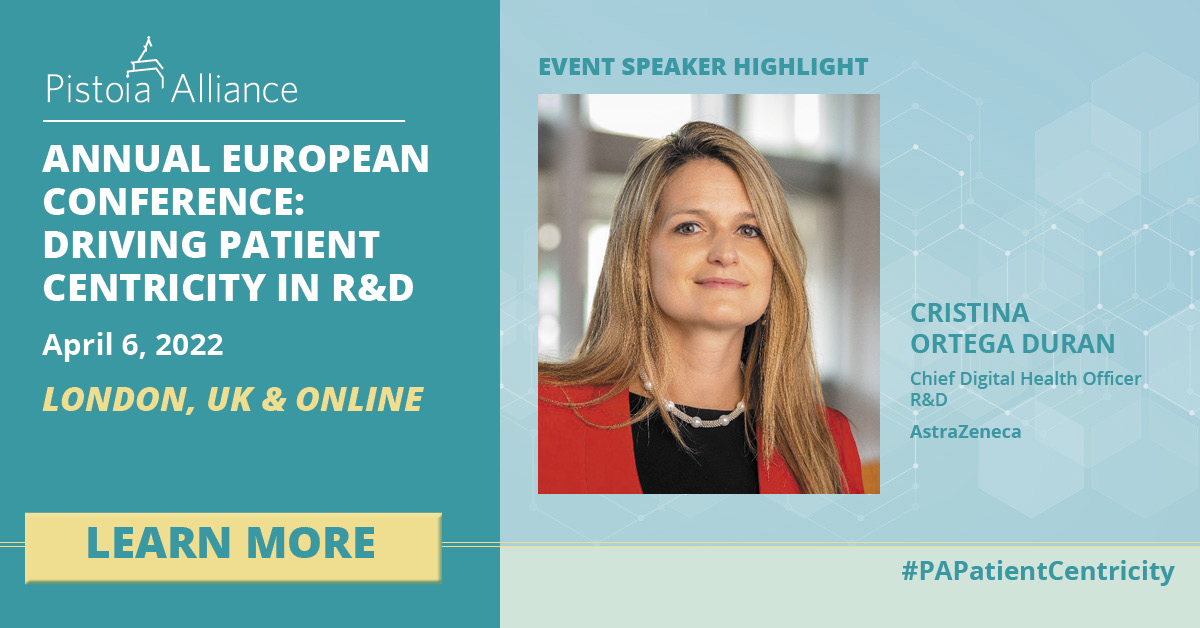 Here at Pistoia Alliance, we are putting the spotlight on patient centricity during our upcoming April 6th conference in London. We have a dynamic lineup of speakers, including keynote Cristina Ortega Duran, Chief Digital Health Officer, R&D at AstraZeneca. We caught up with Cristina ahead of time to give you a glimpse of what to expect from her speech.
Here at Pistoia Alliance, we are putting the spotlight on patient centricity during our upcoming April 6th conference in London. We have a dynamic lineup of speakers, including keynote Cristina Ortega Duran, Chief Digital Health Officer, R&D at AstraZeneca. We caught up with Cristina ahead of time to give you a glimpse of what to expect from her speech.

The pandemic has accelerated the largest transformation in human history due to the rapid expansion of technology combined with the changes to human behavior. For example, to stay connected and healthy, patients of all ages are becoming more comfortable with virtual healthcare visits.
“The future of healthcare is patient-centric,” said Duran. “Leveraging data, analytics and digital, in the future we’ll be able to diagnose patients earlier and treat them with more precision, with the ultimate goal of improving their experience and outcomes.”
Duran is one of the top life science leaders who will speak during the Pistoia Alliance’s conference in London. Her keynote speech, entitled, “Digital Health: Reimagining Health Care with Patients at the Core,” will show that post-pandemic, 75-percent of patients are now comfortable using virtual doctor visits and other digital tools to protect and promote their health.
The key to successful digital transformation, Duran said, is to reach out to patients, to listen carefully to their concerns and preferences, and unify solutions to elevate their experience. Depending on the different patient groups and their specific needs, this might include the latest wearable sensors, monitors and phone apps.
AstraZeneca brings together key team members, in a virtual circle, with the patient at the center — from scientists and software designers to the physicians and safety experts. It starts with asking questions, and truly listening to patient answers, in order to create a successful new way of running clinical trials.
For patients, a better experience on trial means greater comfort, education and a sense of control over their personal, day to day health and quality of life. Clinical trial participants have had to spend long days traveling and having testing done in a hospital setting. As a result, only about 3 percent of eligible patients actually agree to participate in clinical trials. Today, however, approximately 70-percent of the data assessments needed for trials can be done at the patient’s home, Duran said.
“We are bringing technology that really supports a better experience by offering at-home solutions, since we know that’s what many patients prefer for non-urgent care. Following a review of 100s of digital solutions and their applicability to clinical trials, we developed Unify, a patient app and clinical trial support tool that is designed to deliver an optimal experience,” Duran said. “Unify was co-created with patients, using their suggestions to provide solutions to the problems they face. It’s now operating at scale in over 30 countries, demonstrating the impact of working with patients, for patients.”
The digital devices leveraged can vary. Some are wearable, like a watch or blood-pressure cuff, others are similar to small device under your skin like a glucose monitor. These new tools capture a lot of data, so scientists are looking to artificial intelligence (AI) and machine learning to analyze these data and bring forward new discoveries and patterns.
“By using continuous monitoring, you could also improve outcomes. It can help you for example to predict an adverse event, or side effect, by catching it early and keep the patient in closer contact with their care team between visits,” Duran said.
As a thought leader in pharma and life sciences, Duran brings to the conference her many years of experience and expertise in digital transformation. One of her passions is to connect new technology to the patient journey, to make sure patients always feel seen and heard throughout the process of changing the way we do business in healthcare. For patient centricity to be effective, she said, it also must reach across borders to include many countries and regions in the world so it can be truly global.
“To address the critical problems patients face, co-creating solutions is key — not by doing it to them, but with them,” said Duran. “While the technology is innovative and exciting, it’s important to always keep the patient at the center of everything in this new era of biomarkers and targeted, personalized medicine. I am looking forward to coming together with other healthcare leaders at the Pistoia Alliance conference to discuss the role we can all play in creating the patient-centric future.”
If you are a Pistoia Alliance member and you would like to hear the most cutting-edge innovations in life sciences, sign up today and join us in London.
